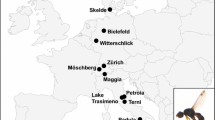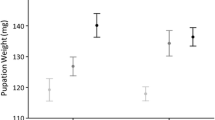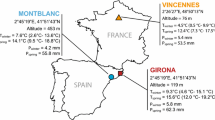Abstract
The trade-offs between body size and development time and between egg size and egg number (clutch size) are central to life history theory, but evidence for them, particularly in terms of genetic correlations, is equivocal. For the yellow dung fly Scathophaga stercoraria (Diptera: Scathophagidae), we investigated variation in phenotypic and genetic variances and covariances, i.e. heritabilities and genetic correlations, of these life history traits (plus diapause) in benign and stressful larval field or adult laboratory food environments. We found both trade-offs to be weak, as evidenced by low phenotypic and genetic correlations, but stronger in the food limited environments. Broad sense heritabilities were generally significant for all traits considered, whereas the narrow sense heritabilities for egg and clutch size were nil. With regard to the question of how environmental stress affects heritabilities, we found a whole range of responses within one single species depending on the traits considered. All three possible patterns occurred, i.e. increased h2 due to increased V G or decreased \(V_{P^{\prime}}\) decreased h2 due to increased \(V_{P^{\prime}}\) and no change in h2 due to increased V G and V P . These can be explained by the particular ecological circumstances yellow dung flies face in their natural environment. Nevertheless, the majority of patterns was consistent with the idea that stressful conditions amplify phenotypic differences between genotypes. Such variable responses of traits even within one organism underscores the complexity of this issue and may well explain the multiple patterns found in various organisms.
Similar content being viewed by others
References
P.A. Abrams O. Leimar S. Nylin C. Wiklund (1996) ArticleTitleThe effect of flexible growth rates on optimal sizes and development times in a seasonal environment Am. Nat. 147 381–395
R.V. Alatalo L. Gustafsson A. Lundberg (1990) ArticleTitlePhenotypic selection on heritable size traits: environmental variance and genetic response Am. Nat. 135 464–471
K. Amano (1983) ArticleTitleStudies on the intraspecific competition in dung breeding flies. I. Effects of larval density on the yellow dung fly Jpn. J. Sanit. Zool. 34 165–175
S.J. Arnold M.J. Wade (1984) ArticleTitleOn the measurement of natural and sexual selection: applications Evolution 38 720–734
W.A. Becker (1992) Manual of Quantitative Genetics EditionNumber5 Students Book Corporation Pullman, WA
B. Bennettova G. Fraenkel (1981) ArticleTitleWhat determines the number of ovarioles in a fly ovary? J. Insect Physiol. 27 403–410
W.U. Blanckenhorn (1997) ArticleTitleAltitudinal life history variation in the dung flies Scathophaga stercoraria and Sepsis cynipsea Oecologia 109 342–352
W.U. Blanckenhorn (1998) ArticleTitleAdaptive phenotypic plasticity in growth, development and body size in the yellow dung fly Evolution 52 1394–1407
W.U. Blanckenhorn (1999) ArticleTitleDifferent growth responses to food shortage and temperature in three insect species with similar life histories Evol. Ecol. 13 395–409
W.U. Blanckenhorn (2002) ArticleTitleThe consistency of heritability estimates in field and laboratory in the yellow dung fly Genetica 114 171–182
Y. Carrière D.A. Roff (1995) ArticleTitleThe evolution of offspring size and number: test of the Smith-Fretwell model in three species of crickets Oecologia 102 389–396
J.M. Cheverud (1988) ArticleTitleA comparison of genetic and phenotypic correlations Evolution 42 958–968
P. Crnokrak D.A. Roff (1995) ArticleTitleDominance variance: associations with selection and fitness Heredity 75 530–540
M.E. Czesak C.W. Fox (2003) ArticleTitleEvolutionary ecology of egg size and number in a seed beetle: genetc trade-off differs between environments Evolution 57 1121–1132
G. Davidowitz L.J. D’Amico H.F. Nijhout (2004) ArticleTitleThe effects of environmental variation on a mechanism that regulates insect body size Evol. Ecol. Res. 6 49–62
G.H. Moed Particlede G. Jong Particlede W. Scharloo (1997) ArticleTitleEnvironmental effects on body size variation in Drosophila melanogaster and its cellular basis Genet. Res. 70 35–43
D. Ebert (1993) ArticleTitleThe trade-off between offspring size and number in Daphnia magna : the influence of genetic, environmental and maternal effects Arch. Hydrobiol. 4 453–473
D. Ebert L.Y. Yampolsky S.C. Stearns (1993) ArticleTitleGenetics of life history in Daphnia magna. I. Heritabilities at two food levels Heredity 70 335–343
D.S. Falconer (1989) Introduction to Quantitative EditionNumber3 Longman Scientific and Technical Harlow
W. Foster (1967) ArticleTitleHormone-mediated nutritional control of sexual behavior in male dung flies Science 158 596–597
C.W. Fox (1993) ArticleTitleMaternal and genetic influences on egg size and larval performance in a seed beetle (Callosobruchus maculatus) – multigenerational transmission of a maternal effect Heredity 73 509–517
J.D. Fry (1992) ArticleTitleThe mixed-model analysis of variance applied to quantitative genetics: biological meaning of the parameters Evolution 46 540–550
S.G. Gebhardt-Henrich A.J. Noordwijk Particlevan (1991) ArticleTitleNestling growth in the great tit I Heritability estimates under different environmental conditions J. Evol. Biol. 3 341–362
D.S. Gibbons (1980) ArticleTitlePrey consumption, mating, and egg production in Scathophaga species (Dipt., Scathophagidae) in the laboratory Entomol. Month. Mag. 116 25–32
C.P. Grill A.J. Moore E.D. Brodie SuffixIII (1997) ArticleTitleThe genetics of phenotypic plasticity in a colonizing population of the ladybird beetle, Harmonia axyridis Heredity 78 261–269
Hoffmann, A.A. and Parsons, P.A. (1991) Evolutionary Genetics and Environmental Stress. Oxford University Press
A.A. Hoffmann J. Merilä (1999) ArticleTitleHeritable variation and evolution under favourable and unfavourable conditions Trends Ecol. Evol. 14 96–101
A. Honek (1993) ArticleTitleIntraspecific variation in body size and fecundity in insects: a general relationship Oikos 66 483–492
P. Jann W.U. Blanckenhorn P.I. Ward (2000) ArticleTitleTemporal and microspatial variation in the intensities of natural and sexual selection in the yellow dung fly Scathophaga stercoraria J. Evol. Biol. 13 927–938
P. Jann P.I. Ward (1999) ArticleTitleMaternal effects and their consequences for offspring fitness in the yellow dung fly Funct. Ecol. 13 51–58
A. Kause I. Saloniemi E. Haukioja S. Hanhimaki (1999) ArticleTitleHow to become large quickly: quantitative genetics of growth and foraging in a flush feeding lepidopteran larva J. Evol. Biol. 12 471–482
J. Kozlowski (1992) ArticleTitleOptimal allocation of resources to growth and reproduction: implications for age and size at maturity Trends Ecol. Evol. 7 15–19
R. Lande S.J. Arnold (1983) ArticleTitleThe measurement of selection on correlated characters Evolution 37 1210–1226
J. Lazarevic V. Peric-Mataruga J. Ivanovic Andjelkovic M. (1998) ArticleTitleHost-plant effects on the genetic variation and correlations in the individual performance of the Gypsy Moth Funct. Ecol. 12 141–148
C.M. Lessells F. Cooke R.F. Rockwell (1989) ArticleTitleIs there a trade-off between egg weight and clutch size in wild lesser snow geese, Anser caerulescens caerulescens? J. Evol. Biol. 2 457–472
M. Lynch B. Walsh (1998) Genetics and Analysis of Quantitiative Traits Sinauer Associates Sunderland, Mass
T. Mappes E. Koskela (2004) ArticleTitleGenetic basis of the trade-off between offspring number and quality in the bank vole Evolution 58 645–650
J. Merilä (1997) ArticleTitleExpression of genetic variation in body size in the collared flycatcher under different environmental conditions Evolution 51 526–536
A.P. Møller J.P. Swaddle (1997) Asymmetry, Developmental Stability, and Evolution Oxford University Press Oxford
T.A. Mousseau D.A. Roff (1987) ArticleTitleNatural selection and the heritability of fitness components Heredity 59 181–198
M. Ojanen M. Orell R.A. Vaisanen (1979) ArticleTitleRole of heredity in egg size variation in the great tit, Parus major, and the pied flycatcher, Ficedula hypoleuca Ornis Scand. 10 22–28
T. Price T. Langen (1992) ArticleTitleEvolution of correlated characters Trends Ecol. Evol. 7 307–310
D.A. Roff (1992) The Evolution of Life Histories: Theory and Analysis Chapman and Hall New York
D.A. Roff (1995) ArticleTitleThe estimation of genetic correlations from phenotypic correlations: a test of Cheverud’s conjecture Heredity 74 481–490
D.A. Roff (1996) ArticleTitleThe evolution of genetic correlations: an analysis of patterns Evolution 50 1392–1403
D.A. Roff (1997) Evolutionary Quantitative Genetics Chapman and Hall New York
D.A. Roff (2000) ArticleTitleTrade-offs between growth and reproduction: an analysis of the quantitative genetic evidence J. Evol. Biol. 13 434–445
L. Rowe D. Houle (1996) ArticleTitleThe lek paradox and the capture of genetic variance by condition dependent traits Proc. R. Soc. Lond. B 263 1415–1421
D. Schluter T.D. Price L. Rowe (1991) ArticleTitleConflicting selection pressures and life history trade-offs Proc. R. Soc. Lond. B 246 11–17
L. Schwarzkopf M.W. Blows M.J. Caley (1999) ArticleTitleLife-history consequences of divergent selection on egg size in Drosophila melanogaster Am. Nat. 154 333–340
R. Shine (1988) ArticleTitleEvolution of large body size in females: a critique of Darwin’s fecundity advantage model Am. Nat. 131 124–131
A. Simons D.A. Roff (1994) ArticleTitleThe effect of environmental variability on the heritabilities of traits of a field cricket Evolution 48 1637–1649
B. Sinervo P. Doughty (1996) ArticleTitleInteractive effects of offspring size and timing of reproduction on offspring reproduction: experimental maternal, and quantitative genetic aspects Evolution 50 1314–1327
C.C. Smith S.D. Fretwell (1974) ArticleTitleThe optimal balance between size and number of offspring Am. Nat. 108 499–506
R.J. Snyder (1991) ArticleTitleQuantitative genetic analysis of life histories in two freshwater populations of the threespine stickleback Copeia 1991 526–529
S.C. Stearns (1992) The Evolution of Life Histories Oxford University Press Oxford
G.S. Su L.E. Liljedahl G.A.E. Gall (1997) ArticleTitleGenetic and environmental variation of female reproductive traits in rainbow trout Aquaculture 154 115–124
A.J. Noordwijk Particlevan G. Jong Particlede (1986) ArticleTitleAcquisition and allocation of resources: their influence on variation in life history tactics Am. Nat. 128 137–142
S. Via (1984) ArticleTitleThe quantitative genetics of polyphagy in an insect herbivore. II. Genetic correlations in larval performance within and among host plants Evolution 38 896–905
I. Weigensberg D.A. Roff (1996) ArticleTitleNatural heritabilities: can they be reliably estimated in the laboratory? Evolution 50 2149–2157
R.J. Wootton (1979) ArticleTitleEnergy cost of egg production and environmental determinants of fecundity in teleost fishes Symp. Zool. Soc. Lond. 44 133–159
A.J. Zera L.G. Harshman (2001) ArticleTitleThe physiology of life history trade-offs in animals Ann. Rev. Ecol. Syst. 32 95–126
Author information
Authors and Affiliations
Corresponding author
Additional information
Co-ordinating editor: Leimar
Rights and permissions
About this article
Cite this article
Blanckenhorn, W.U., Heyland, A. The quantitative genetics of two life history trade-offs in the yellow dung fly in abundant and limited food environments. Evol Ecol 18, 385–402 (2005). https://doi.org/10.1007/s10682-004-2680-z
Received:
Accepted:
Issue Date:
DOI: https://doi.org/10.1007/s10682-004-2680-z




